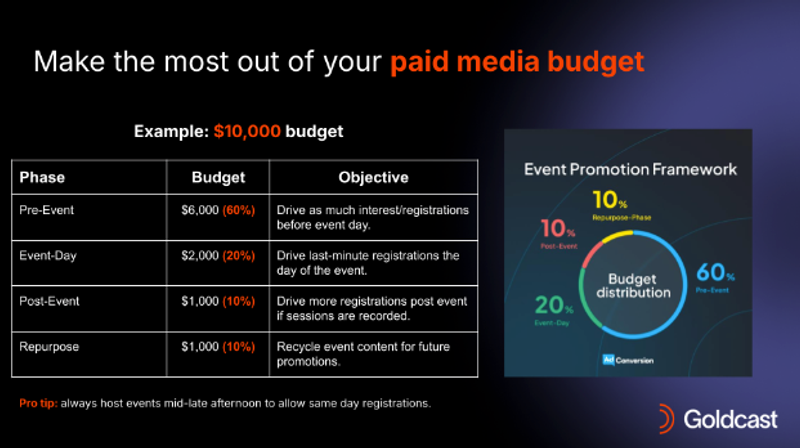Event Promotion Tips That Drive Registration and Attendance—Plus, How To Spend Your Media Budget

Table of Contents
Maximize Your Marketing ROI
Join 10,000 other marketers already getting the best tips on running engaging events that boost pipeline and create raving fans.
Successful event promotion is so much more than dropping your event link in an email campaign and pressing "Send." (If only!)
In reality, we have to think about each touchpoint in the promo process and how it's received by our audience. We also have to get everyone on our team excited about the event so they'll help us promote it. Oh, and there's a paid budget to allocate. And so much more!
To learn more about how marketers across the world drive registration and promote their events and webinars, Lindsay McGuire, our Associate Director of Content and Campaigns chatted with:
- Leonardo Pizarro, Director of Demand Generation at Eye Security and certified hummus lover (ask him how this relates to marketing!)
- Liam Bartholomew, VP of Marketing at Cognism (and VIP Goldcast customer 🏆)
- Silvio Perez, Founder at AdConversion and our panel's resident ads expert
When it comes to promoting events, the panel shared these tips:
- Remove the friction and make conversion easy
- Rally the troops for hype marketing 📣
- How to spend your paid media budget across the four event phases
- 5 tips to maximize paid event promotion
- Closing marketing tips from Cognism
Watch the full event to learn about more than just promo — from converting your target audience to repurposing your content to be more efficient!
Remove the friction and make conversion easy
As privacy regulations and restrictions tighten globally, marketers have to think about how to provide an easy, frictionless experience for registrants while still being compliant.
At every step of the process, ask yourself whether the step you're asking your registrant to take is truly necessary. Do people really need to fill out a form identifying themselves if you know who they are? Are you having people input information in different places so you'll have it across platforms, when you could get that done another way?
There are two easy, cost-effective ways to drive tons of registrations and make it simple for your audience:
- LinkedIn lead-gen events: You can easily invite 1,000 of your network connections on LinkedIn, and it only takes a few minutes. This explains why you see LinkedIn events with 10K+ attendees! Plus, you can ask speakers and influencers to invite their networks as well, leaving you with a massive pool of first-party data to work with.
- One-click registration links in your CRM: When you're sending out the traditional email campaign to promote your event, allow your known customers to skip the form. You can just offer them a link to click that opts them into the webinar but doesn't require any further information from them.
The future, as full of AI as it promises to be, likely holds more of this type of experience. Less work on the user side and more relying on platform info instead!

Rally the troops for hype marketing 📣
Leonardo uses the term "hype marketing" to refer to creating so much buzz around your campaign that everyone wants to collaborate with you and help promote your event.
We're sold!
Hype marketing can often be the difference between a successful event campaign and low registrations because you only relied on paid promo. With hype marketing, multiple stakeholders are being proactive early on about inviting their contacts to attend.
There are two factions who are involved:
Internally, empower your team to be campaign ambassadors. Encourage folks to share on social and on Slack channels. Involve every department you can! Get buy-in from influential leaders in the company and ask them to shout from the rooftops about your event.
You might even up the ante by incentivizing your team with challenges and competitions. Gamifying the promotion period can really make it fun for everyone!
Externally, look to partners, customers, champions, speakers, and industry allies. Companies that don't directly compete with you but still have a shared audience are a great choice, and you can split promo costs, which is always a plus! #budgetfriendly
How to spend your paid media budget across the four event phases

Silvio walked us through how to effectively spend your money to promote your event. This can apply to any event, big or small, and to any budget. You'd just apply the percentages accordingly.
There are four phases to divvy your budget between. Let's talk more about each!
Pre-event
What to spend and why: The majority of your budget (60%) will go toward pre-event promo. Going back to that idea of hype marketing, you really want to get people excited, interested, and engaged long before the event happens — so throw most of your money behind it!
Creative focus: In this phase, be sure that the creative assets you're using are pulling their weight. Use emotionally compelling power words instead of generic language. Create video snippets that show folks what it would feel like to be a part of this event. Craft on-brand design elements that tie everything back to your overarching messages.
Event day
What to spend and why: A lot of people stop promoting after the pre-event phase, but that's a mistake. 20% of your budget should be used on the event day!
Instead of turning off your promo campaigns on the day of the event, host your events mid-to-late afternoon and run a same-day event campaign. This will push same-day registrations, and it's especially important for paid events because ticket sales tend to spike right before the actual event.
Creative focus: Capitalize on FOMO. Use countdown timers to let people know their time is limited to sign up. Tease more videos that show people what exactly they'll experience by attending this event, and push them to sign up right now so they don't miss out.
Post-event
What to spend and why: Now that the event is over, use 10% of the budget to promote the on-demand recording. That way, you can get utility out of the event long after it's over.
Creative focus: Try email campaigns and social media posts to promote the on-demand version and again, use FOMO to your advantage and show people what they missed out on and why they should sign up for future events.
Repurpose
What to spend and why: Finally, 10% of your budget should go toward repurposing content in order to recycle it across platforms and reuse it for future promotions.
Creative focus: Try Goldcast Content Lab, an AI-powered repurposing studio that will quickly turn your events into a ton of reusable assets.
5 tips to maximize paid event promotion
Now that we know how to allocate our budget, let's talk about some general tips to maximize your promo efforts.
Promote speakers + attendees + topics
Silvio's tested promo assets extensively, and he's found that the ads that perform the best are the ones that showcase speakers, attendees, and topics. Try to focus on these three pillars when you're creating your promo and campaign assets.
Here are some ideas on how to highlight each:
- Speakers: This might be a LinkedIn post from the speaker that you then promote as an ad, or you might create a single image ad showcasing the topic and the speaker's title. Speakers might also be willing to create casual videos on their phones that you can use. If you have a lot of speakers, try making a poster image that shows all of them — at a glance, people can tell there's a lot of value to attending this event!
- Attendees: When applicable, if you have past attendees who would want to provide testimonials or tell you what they're looking forward to, that can be powerful social proof to use in ads.
- Topics: Be sure you've chosen a topic that is timely and speaks to a pain point in your industry — your ad performance will suffer if not. Be sure to showcase your topics and illustrate what people will receive from the event, so they understand the value.
Highlight an event hashtag in all ad copy (#LikeThis2024)
Use a hashtag to tie all of your promo assets together. Silvo recommends adding the hashtags at the top of your posts so that people can easily click on them and then go down the proverbial rabbit hole to learn more and see all of your promotional materials.
Why the top of the ad? This is to remove friction from the audience experience (remember that first point we made about making things easy for registrants?). Even if someone doesn't scroll all the way to the bottom of your ad or make it to the CTA, they can still click that hashtag and get more social proof and validation as to whether your event is a good choice.
Use clear and specific messaging
Clear messaging always wins over anything else. Remember that copy is visual first before someone takes the time to actually read it, and format accordingly. Use bullet points and emojis, and break walls of text up so they're easy to scan.
Test native lead forms for small events and webinars
When you're doing a large-scale conference, it makes sense to send someone to a registration page so they can learn more about the speakers, event lineup, investment cost, and more. However, for small events and webinars, things should be — you guessed it — frictionless.
Use pre-populated lead forms whenever possible to increase your attendance rates and make it simple for folks to sign up. You can seamlessly integrate a Slack alert from lead form opt-ins as a way to monitor lead quality in real time!
Experiment outside of LinkedIn (YouTube, Meta, Twitter/X)
This is a huge missed opportunity for many marketers. If you're only promoting your event on LinkedIn, getting a ton of registrations is gonna be tough. Especially for a large-scale event where you're looking to bring in like 20K registrants, it's going to require a full-scale, multi-channel effort.
Silvio's favorite channels are YouTube, Meta, and Twitter. These are relatively low-cost channels where you can get in front of your ICPs and drive more registrations. Give it a try for your next event!
Closing marketing tips from Cognism
Liam rounded out the group by sharing some fast marketing tips that are working for the Cognism team.
Here's an overview:
- Email remains a dominant channel for event registrations. Liam has experimented with both HTML and text-based emails and had success with different ones, depending on the event and the intent.
- Embed your promo into your workflows. Set up an event landing page that's always on, and don't share the date of an event. When people register, they get pulled into a list and an email goes out so that people can register for that event at any point, when they're ready to. Other places to embed promo: onboarding decks, customer service processes, sales workflows, etc.
- Use content threading in your ABM strategy. Take your target list of accounts, and invite those people to take part in your content. That translates to engagement in the account and extra (free!) promotion and social proof for your event.
- Try in-product promotions to consistently push promos out for recurring events. If the main audience for an event lives in one of your products, this is a great way to let them know about it. There's also no chance of opt-outs because while people can reject the notification, you can send another one later on for the next event.
- Leverage influencer and community promotion as much as possible. Your influencers and community members have big networks of their own, and you should tap into that!
- Localization matters. If you're operating in a global network, be sure that you're using natural language for all of your marketing assets. It's going to create friction (we know, you've never heard that word so much as you have today!) if someone receives an invite in English and then turns up to an event spoken only in French. Tailor your promo efforts accordingly.
And that concludes the group's mega-helpful tips on promoting events!
Remember: These guys talked about so much that we couldn't go through here — from how to hook your target audience, to creating strong pipelines, to the post-event repurposing journey, and so much more. Catch up below and let us know what you think!
Transform Your Video Marketing with AI
Stay In Touch
Platform
Resources
© 2025 Copyright Goldcast, Inc. All rights reserved.





 Upcoming Events
Upcoming Events Event Series
Event Series On-Demand Events
On-Demand Events

